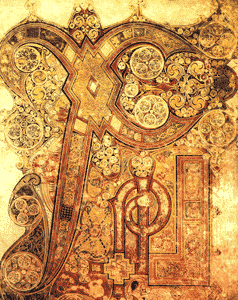by Mercy Paddock Van Vlack with Alexei Kondratiev

The art illustrating the 2001 Celtic Calendar comes from a bog, from the Thames river, and from thistle-strewn graveyards. The art of the Celts is from the land and water, and in payment for what they took for nourishment and inspiration and protection, they gave back and sacrificed their beautiful enamelled Battersea shield to the river, a gift for the Gods.
The distinctively Celtic style of art is ancient. No written history comes to us from Celtic communities through the ages until the Greeks and Romans described their ways. What we do have is carved stone, ancient enamelled bronze and gravemounds of kings exhibiting the twisted spirals and fantastic creatures of what we have come to call “Celtic art”. By the 6th century BCE, skilled Celtic craftsmen were reproducing art motifs they found on objects imported from the Greek and Etruscan worlds, but already reflecting characteristic Celtic interests and tastes.
Around 450 BCE a great flowering of Celtic art took place, with new developments in style that expressed a fresh, self-confident approach to native tradition. The many motifs imported from Greek and Asian art were re-interpreted in an abstract, geometrical direction, with curved shapes and empty spaces balancing each other in playful asymmetrical patterns, often deliberately suggesting movement. This immediately recognisable, quintessentially Celtic style is referred to as the La Tène style by archaeologists and art historians, after a site in Switzerland where many objects were found thrown into a lake as ritual offerings. Pieces of decorated weapons and other metal objects in this style (wave patterns, stylised plant and animal shapes and abstract decorations on functional objects) have been found throughout Europe, but especially in France, Switzerland, Germany and Britain. The Battersea Shield, a particularly good example of the style, appears on the cover of the Celtic Calendar 2001 in the upper right hand corner and again in March on the chest of the Celtic Warrior.
The Book of Kells is another famous source of Celtic art, where the monks from the 9th century AD illuminated pages of the bible with tiny complicated interlocking weavings, always going back to the beginning, each piece one endless line. Some creatures interlock their legs into other figures and snakes, emmeshed in a fish-net of decorative lines that perfectly fill every available inchlet of space in the page design. Some of these precise intricate drawings are the size of a dime. This style (which is the one people most often associate with the term “Celtic art”) developed ca. 700 AD in the monasteries of the Columban community which had spread from Ireland into Scotland and northern England. It was inspired by illuminated manuscripts from Egypt, Syria and the Byzantine world. Egyptian decorative art of the period made frequent use of simple interlace. Celtic monks copied the technique but took it to heights of complexity that had never before been imagined. This style is usually referred to as “Hiberno-Saxon“. It was eventually adapted to relief work on stone, as can be seen on the Irish high crosses and some of the Pictish stones, which also show remains of the earlier La Tène style.
As one of the artists on the Celtic Calendar 2001, I spent hours looping endless loops to make sure it worked - over, under, over, the weaving HAS to work! Otherwise you can't take the pathway. One person I talked to uses the Celtic Calendar as a meditation device to calm patients with attention deficit problems, they follow the maze of lines around the borders.
When I'm drawing, it's like a meditation. I go into a state of concentration where the lines flow and bend and I can believe there is magic in the lines. There's an interesting novel by R.A. MacAvoy called “The Book of Kells” which explores the magic of Celtic spirals and its relevance to both the ancient and the modern worlds. A friend of mine who grew up in Ireland says the Monks were there, day in and out, lettering these huge books, and they got bored, so they doodled these in the margins!

Celtic art has become popular as tattoo art, and you'll see it enscribed in the flesh of young people along with South Sea graphics and Northwest Coast Indian designs. The complex graphic patterns appeal today as they were possibly worn into battle painted on the warriors with woad in early Celtic times. You'll see Maxine Miller's art in the Celtic Calendar 2001 and find Cernunnos and Epona with tattoos. Ancient jewelry has been found with these designs, giving the modern artist models to work with. I recently got earrings with a ravens-entwined motif made by a Welsh woman who shares my ethnicity and my love of birds and a delight in the twining of Celtic art.
So you'll find both the ancient and the modern in the Celtic Calendar as the Celtic League American Branch endeavours to keep the flags flying and keep the Languages and Art of the Celtic people alive.
To purchase the Calendar or Celtic Calendar note cards featuring Mercy's artwork, click here.